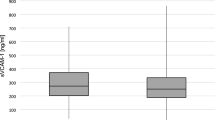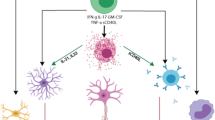Abstract
Background
Subcutaneous IFNβ-1b (Betaferon®) is an established immunomodulatory treatment for relapsing remitting MS and active secondary progressive multiple sclerosis (SPMS). It modulates cytokine and adhesion molecule expression but long term in vivo effects of IFNβ-1b on the immune system are not known in multiple sclerosis.
Objective
To address the effects of IFNβ-1b on serum levels for soluble adhesion molecules and cytokine receptors from MS patients.
Methods
Serial blood samples were obtained from 40 patients of the frequent MRI subgroup (20 patients each from the placebo and the IFNβ-1b treatment group), participating in the European multi-center clinical trial with IFNβ-1b for secondary progressive MS, at regular intervals for up to 36 months. Soluble adhesion molecules (sVCAM, sICAM-1, sL-Selectin) as well as TNF-receptor I and II were analysed in the serum of patients by enzyme linked immunosorbent assays (ELISAs). Monthly brain MRI was performed in 34 of these patients (16 patients from the placebo and 18 from the IFNβ-1b group) during months 1–6 and 19–24 to monitor disease activity as assessed by newly occurring gadolinium (Gd) enhancing lesions.
Results
An early and significant increase in sVCAM and sTNF-RII serum levels was detected in 16 out of 20 patients (80 %) treated with subcutaneous IFNβ-1b already at month 1 but was absent in all but one patient during placebo treatment (p<0.01). Raised sVCAM and TNF RII serum levels during months 1–6 inversely correlated with less MRI activity in the 19–24 months treatment interval in the IFNâ-1b treatment group ( p=0.0093 for TNF-RII; p=0.047 for VCAM).
Conclusions
sVCAM and sTNF RII levels in the serum of SPMS patients are increased during IFNβ-1b therapy and may at least in part explain some of the treatment effects, like reduced immune cell transmigration.
Similar content being viewed by others
References
Byrnes A, McArthur J, Karp C (2002) Interferon-beta therapy for multiple sclerosis induces reciprocal changes in interleukin-12 and interleukin-10 production. Ann Neurol 51:165–174
Calabresi PA, Tranquill LR, Dambrosia JM, Stone LA, Maloni H, Bash CN, et al. (1997) Increases in soluble VCAM-1 correlate with a decrease in MRI lesions in multiple sclerosis treated with interferon beta-1b. Ann Neurol 41:669–674
Calabresi PA, Prat A, Biernacki K, Rollins J, Antel J (2001) T lymphocytes conditioned with Interferon beta induce membrane and soluble VCAM on human brain endothelial cells. J Neuroimmunol 115:161–167
Dore-Duffy P, Washington R, Dragovic L (1993) Expression of endothelial cell activation antigens in microvessels from patients with multiple sclerosis. Adv Exp Med Biol 331:243–248
European Study Group on Interferon beta-1b in Secondary Progressive MS (1998) Placebo-controlled multicentre randomised trial of interferon beta-1b in treatment of secondary progressive multiple sclerosis. Lancet 352:1491–1497
Floris S, Ruuls S, Wierinckx A, van der Pol S, Döpp E, van der Meide P, Dijkstra CD,De Vries HE (2002) Interferon-beta influences monocyte infiltration into the central nervous system. J Neuroimmunol 127:69–79
Galboiz YM (2002) Immunological indicators of disease activity and prognosis in multiple sclerosis. Curr Opin Neurol 15:233–237
Goodin D, Frohman E, Garmany G, Halper J, Likosky W, Lublin F, et al. (2002) Disease modifying therapies in multiple sclerosis—Report of the therapeutics and technology assessment subcommittee of the American academy of neurology and the MS council for clinical practice guidelines. Neurology 58:169–178
Hartung HP, Reiners K, Archelos JJ, Michels M, Seeldrayers P, Heidenreich F, et al. (1995) Circulating adhesion molecules and tumor necrosis factor receptor in multiple sclerosis: Correlation with magnetic resonance imaging. Ann Neurol 38:186–193
Hummel V, Kallmann B, Füller T, et al. (2001) Production of MMPs in human cerebral endothelial cells and their role in shedding of adhesion molecules. J Neuropathol Exp Neurol 60:320–327
Kallmann B, Hummel V, Ruprecht K, Toyka KV, Rieckmann P (2000) Cytokin-induced modulation of cellular adhesion to human cerebral endothelial cells is mediated by soluble vascular cell adhesion molecule-1. Brain 123:687–697
Khoury SJ, Orav EJ, Guttmann CR, Kikinis R, Jolesz FA, Weiner HL (1999) Changes in serum levels of ICAM and TNF-R correlate with disease activity in multiple sclerosis. Neurology 53:758–764
Kollias G, Kontoyiannis D (2002) Role of TNF/TNFR in autoimmunity: specific TNF receptor blockade may be advantageous to anti-TNF treatments. Cytokine Growth Factor Rev 13:315–321
Kraus J, Bauer R, Chatzimanolis N, Engelhardt B, et al. (2004) Interferon-β1b leads to a short-term increase of soluble but long-term stabilisation of cell surface bound adhesion molecules in multiple sclerosis. J Neurol 251:464–472
Laske C, Oschmann P, Tofighi J, Kuhne B, Diehl H, Bregenzer T, et al. (2001) Prognostic value of soluble tumor necrosis factor receptors 1 and 2 in multiple sclerosis patients treated with interferon beta-1b. Eur Neurol 46:210–214
Leppert D, Waubant E, Burk MR, Oksenberg JR, Hauser SL (1996) Interferon beta-1b inhibits gelatinase secretion and in vitro migration of human T cells: a possible mechanism for treatment efficacy in multiple sclerosis. Ann Neurol 40:846–852
Matsuda M, Tsukada N, Miyagi K, Yanagisawa N (1995) Increased levels of soluble vascular cell adhesion molecule-1 (VCAM-1) in the cerebrospinal fluid and sera of patients with multiple sclerosis and human T lymphotropic virus type-1-associated myelopathy. J Neuroimmunol 59:35–40
Matusevicius D, Kivisakk P, Navikas V, Tian W, Soderstrom M, Fredrikson S, et al. (1998) Influence of IFN-beta1b (Betaferon) on cytokine mRNA profiles in blood mononuclear cells and plasma levels of soluble VCAM-1 in multiple sclerosis. Eur J Neurol 5:265–275
Rep MH, Schrijver HM, van Lopik T, Hintzen RQ, Roos MT, Ader HJ, et al. (1999) Interferon (IFN)-beta treatment enhances CD95 and interleukin 10 expression but reduces interferongamma producing T cells in MS patients. J Neuroimmunol 96:92–100
Rieckmann P, Martin S, Albrecht M, Kitze B, Weber T, Tumani H, et al. (1994) Serial analysis of circulating adhesion molecules and TNF receptor in serum from patients with multiple sclerosis: cICAM-1 is an indicator for relapse. Neurology 44:2367–2372
Rieckmann P, Altenhofen B, Riegel A, Baudewig J, Felgenhauer K (1997) Soluble adhesion molecules (sVCAM-1 and sICAM-1) in cerebrospinal fluid and serum correlate with MRI activity in multiple sclerosis. Ann Neurol 41:326–333
Rieckmann P, Kallmann B, Altenhofen B, Riegel A, Felgenhauer K (1998) Quantitative correlation of soluble adhesion molecules in blood and CSF with MRI activity. Mult Scler 4:178–182
Rieckmann P, Toyka KV (1999) Austrian, German and Swiss Multiple Sclerosis Therapy Consensus Group (MSTCG) Escalating immunotherapy of multiple sclerosis. Eur Neurol 42:121–127
Segal B, Cross A (2000) Fas(t) track to apoptosis in MS: TNF receptors may suppress or potentiate CNS demyelination. Neurology 55:906–907
Stone LA, Frank JA, Albert PS, Bash C, Smith ME, Maloni H, et al. (1995) The effect of interferon-beta on blood-brain barrier disruptions demonstrated by contrast-enhanced magnetic resonance imaging in relapsing-remitting multiple sclerosis. Ann Neurol 37:611–619
Stürzebecher S, Wandinger KP, Rosenwald A, Sathyamoorthy M, Tzou A, Mattar P, Frank JA, Staudt L, Martin R, McFarland HF (2003) Expression profiling identifies responder and nonresponder phenotypes to interferon-beta in multiple sclerosis. Brain 126:1419–1429
The Lenercept Multiple Sclerosis Study Group and The University of British Columbia MS/MRI Analysis Group (1999) TNF neutralization in MS—Results of a randomized, placebo-controlled multicenter study. Neurology 53:457–465
Vajkoczy P, Laschinger M, Engelhardt B (2001) Alpha4-integrin-VCAM-1 binding mediates G protein-independent capture of encephalitogenic T cell blasts to CNS white matter microvessels. J Clin Invest 108:557–565
van Boxel-Dezaire A, van Trigt-Hoff S, Killestein J, Schrijver H, van Houwelingen J, Polman C, et al. (2000) Contrasting responses to interferon beta-1b treatment in relapsing-remitting multiple sclerosis: does baseline interleukin-12p35 messenger RNA predict the efficacy of treatment? Ann Neurol 48:313–322
Wandinger K, Sturzebecher C, Bielekova B, Detore G, Rosenwald A, Staudt L, et al. (2001) Complex immunomodulatory effects of interferon-beta in multiple sclerosis include the upregulation of T helper1-associated marker genes. Ann Neurol 50:349–357
Wandinger KP, Lünemann JD, Wengert O, et al. (2003) TNF-related apoptosis inducing ligand (TRAIL) as a potential response marker for interferon-beta treatment in multiple sclerosis. Lancet 361:2036–2043
Author information
Authors and Affiliations
Corresponding author
Rights and permissions
About this article
Cite this article
Rieckmann, P., Kruse, N., Nagelkerken, L. et al. Soluble vascular cell adhesion molecule (VCAM) is associated with treatment effects of Interferon beta-1b in patients with Secondary Progressive Multiple Sclerosis. J Neurol 252, 526–533 (2005). https://doi.org/10.1007/s00415-005-0681-7
Received:
Revised:
Accepted:
Issue Date:
DOI: https://doi.org/10.1007/s00415-005-0681-7




